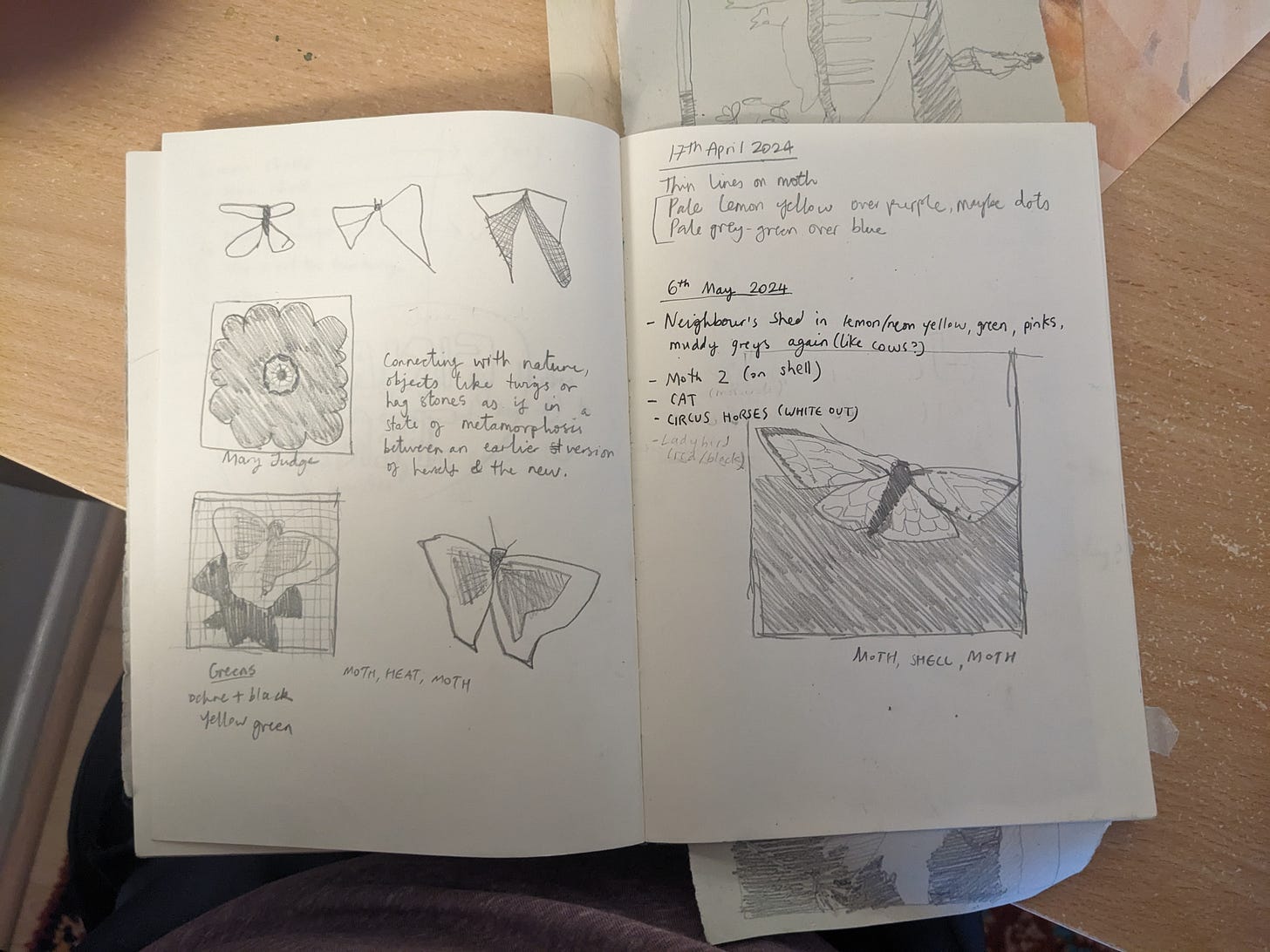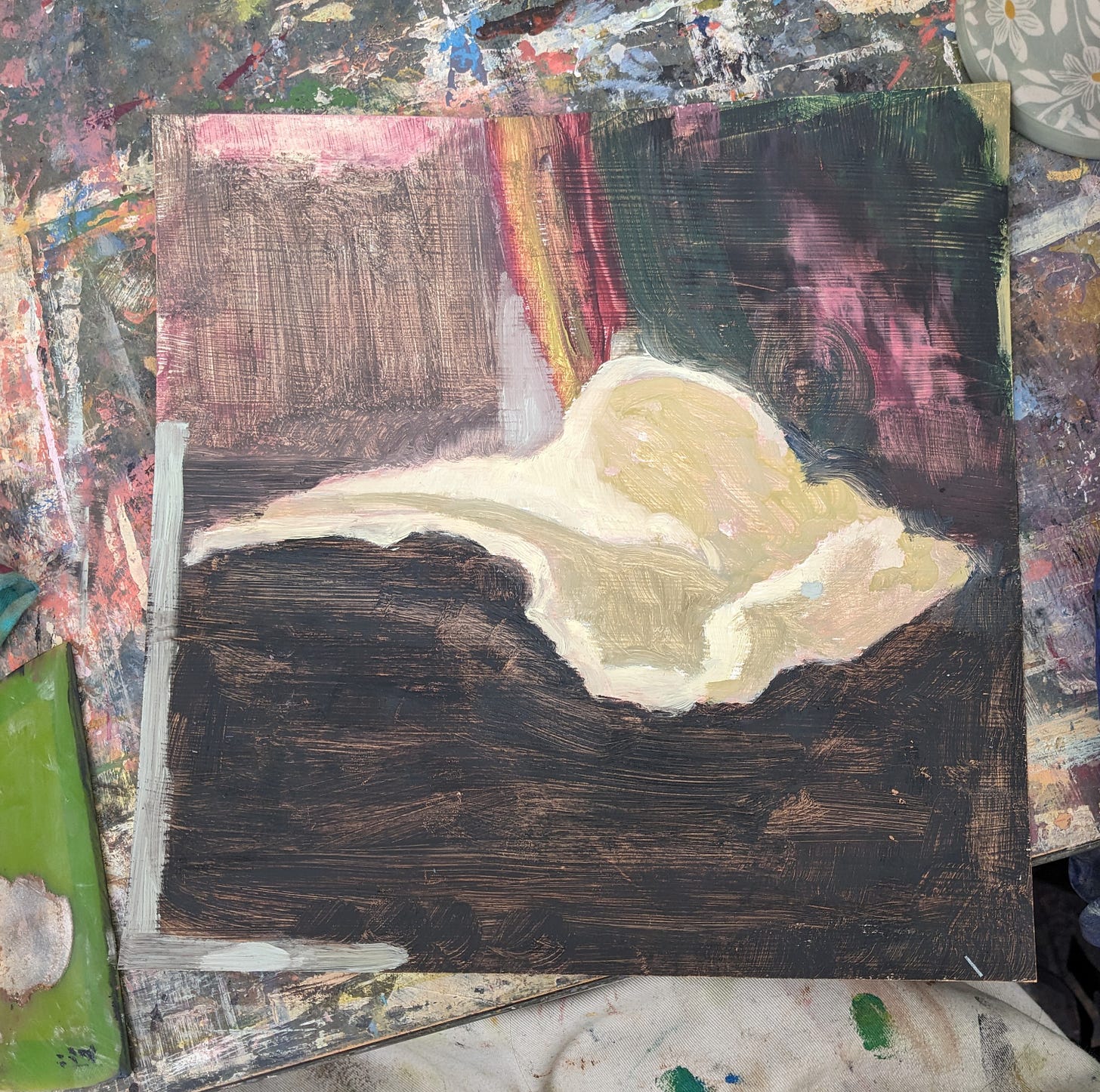I wasn’t sure about making this week’s email another moth-related one, but a really special friend recently bought one of my oil paintings, Nightglow Moth and I wanted to write a thank you note in the form of a behind the scenes digest.
Telling the story of a painting is strange work, because it’s quite literally weeks, even months of time condensed into a few minutes’ worth of words. Painting is usually such blurry haze for me that re-tracing steps really feels like fumbling in the dark. Nonetheless, trying to give a little insight into my process is my best way of expressing gratitude for anyone kind enough to buy my work. I hope that knowing more about my paintings give it even more value and meaning. These ‘Underpainting’ newsletters won’t be very frequent, but if you’re interested, I’ll be doing these writeups every now and again.
PART 1: Where it began
It all started with a still life of a shell I had collected about a decade ago from Jaffna shores. But only a couple hours into mixing colours and painting, I lost interest. I was too exhausted to concentrate and I thought better to throw caution to the wind than struggle through tiredness.
So there I was, mucking about with paint, potentially ruining what could have been a perfectly lovely still life. I thinned out the oil paint so that it would catch against the grain of the primer underneath and so that you could visibly see each brush stroke sweeping across the page. I went for jewel colours which I ordinarily wouldn’t use – forest greens, deep reds, inky blacks and browns – then lightly scrubbed the colours back with a clean brush, or smooshed them together with a squeegee. My approach was careless, but I had nothing to lose. Plus it was that time of day where your brain shuts down and you feel a little delusional, so I really was just going for it. By 5pm it ended up looking like a bit of a murky mess:
PART 2: Stumbling in the dark
The next day, or maybe the next week (I can’t quite remember the timeline) I decided to pick the painting up again and try turning it into something worthwhile. My first thought was to subdue some of the darkness and rich tones from the initial layer. I chose to work with earthy greens, muted oranges, warm browns, and soft pinks from the Zorn palette. Like last time, I focused on creating directional, visible brush strokes with transparent oil paint, but this time I was more intentional about it: repeated, energetic verticals on the top section. Repeated, understated horizontals on the bottom to contrast. By no means did I didn’t have a vision of where I was going with it all, but I felt a lot more in control.
I had also been thinking a lot about Vuillard’s paintings during this time, and inspired by his works, pattern became a tool I reached for a lot. So after painting those directional lines to cover the darkness of the base layer, I took inspiration from the Nabis legend himself and added some dotted strokes to add interest. I have taken so many cues from Vuillard’s work over the past year – the dotted pattern here being one of them – and without his influence I don’t think this piece would feel as special as it does now.

PART 3: Time is your dearest friend
I had really hoped that I was onto something at this point, but truthfully I couldn’t see a future for the painting. I asked one of my tutors for feedback on it, and he said it looked done to him. Though I agreed it was interesting, I disagreed that it was done. He said to leave it alone either way – and I complied. Even now, I consider this one of the most important lessons I learnt at art school. Letting time pass when you don’t know what to do – in art or in life – can be such a valuable thing.
So Nightglow Moth – then unnamed of course – was covered up and stashed away in my bag of works-in-progress for about a month and a half.
PART 4: Taking flight
It was only a mere few weeks before the end of year show at LSA, that the final form of the painting came to me. I quickly scribbled down the vision that popped into my head.

In the serendipitous way that my oil pieces often come to be, a lot of the final moves I made for this painting were a matter of chance. I could have sat down and planned what colours to use for the moth, and carefully considered how I was going to apply the paint. I could have thought long and hard about how I was going to make the moth gel visually with the layers I had already put down on the surface. I could have mapped out the image so that final painting perfectly mirrored my sketch. But I didn’t. I simply looked at my palette, picked up the leftover colours on it and let intuition guide my hand. Deep red for the fluffy body and hot pink for the delicate wings. A dash of icy purple underneath. A streaky dark stripe along the top left edge. I didn’t think. I just did. And that was that. My gut finally said: it’s done.
In many ways, this painting has taught me the most about the process of making. Some paintings I wrestle with for months on end, and it takes me ages to realise that fighting my way through isn’t going to help. But Nightglow Moth came to me in its own time. It taught me that my best art isn’t made in the struggle. It’s made in patience. It’s made in letting things brew. It’s made in rest. And today on a gloomy afternoon in Edinburgh, I’m realising, I could really use a little time to turn inward into my own cocoon.





